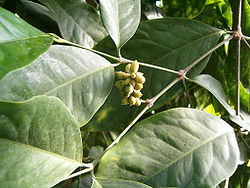- Gnetum gnemon
-
 Gnetum gnemon
Gnetum gnemonGnetum gnemon Classification classique Règne Plantae Sous-règne Tracheobionta Division Gnetophyta Classe Gnetopsida Ordre Gnetales Famille Gnetaceae Genre Gnetum Nom binominal Gnetum gnemon
L. Retrouvez ce taxon sur Wikispecies
Retrouvez ce taxon sur Wikispecies
D'autres documents multimédia
sont disponibles sur CommonsGnetum gnemon est une espèce de Gnetum originaire d'Asie du Sud-Est et de la partie occidentale de l'océan Pacifique. D'ouest en est, on la rencontre en Assam, en Asie du Sud-Est continentale et insulaire et aux îles Fidji. Ses noms locaux sont peesae (thai), bét, rau bép, rau danh ou gắm (vietnamien), melinjo ou belinjo (indonésien, bago (tagalog), muling (aceh), dae (kwara'ae), sukau (tonga). They are sometimes called padi oats or paddy oats.
It is a small to medium-size tree (unlike most other Gnetum species, which are lianas), growing to 15-20 m tall. The leaves are evergreen, opposite, 8-20 cm long and 3-10 cm broad, entire, emerging bronze-coloured, maturing glossy dark green. The fruit-like strobilus consist of little but skin and a large nut-like seed 2-4 cm long inside.
Fleshy strobili weigh about 5.5 g, the seed alone 3.8 g. Strobili mature mainly from June to September in NE Philippines. The red strobili are eaten by birds, mammals and reptiles.
Uses
This plant is commonly cultivated throughout Aceh region and is regarded as vegetable of high status. Its flower, young leaves and fruits are used as ingredients of traditional vegetable curry called kuah pliek. This dish is served in all important traditional occasions, such as khanduri and keureudja. In Pidie district, the women pick the ripe fruits (its skin color is red) and make keureupuk muling (crackers) from it. It is widely used in Indonesian cuisine. The seeds are used for sayur asem (sour vegetables soup) and also, grind into flour and deep-fried as crackers (emping, a type of krupuk). The crackers have a slightly bitter taste and are frequently served as a snack or accompaniment to Indonesian dishes. The leaves are also commonly used for vegetables dishes in Indonesia.
Recently, Japanese scientists found that Gnetum gnemon is not the cause of gout disease (uric acid disease).[1]
Melinjo is native to Indonesia and very popular in this country. At the present, Melinjo Extract is produced and supervised under cooperation between Indonesian Agricultural Association (NOFA (id:KTNA) ; Ikamaja's Mother Organization) and JASMELINDO (Japanese Non-Profit Organization), to protect certain profit for Indonesian farmers.[citation nécessaire]
Phytochemicals
Lately, it is found that melinjo strobili are rich in polyphenol component which is called resveratrol. The resveratrol substances that found in melinjo is identified as dimer form and was published in XXIII International Conference on Polyphenols, Canada, in 2006.[citation nécessaire]
Melinjo resveratrol, having antibacterial and antioxidative activity[2], exhibit good effects as food preservative, off flavour inhibitor and taste enhancer[3]. They become of importance in food industries which do not use any synthetic chemicals in their processes.
Four new stilbene oligomers, gnemonol G, H, I and J, were isolated from acetone extract of the root of Gnetum gnemon along with five known stilbenoids, ampelopsin E, cis-ampelopsin E, gnetin C, D and E[4].
Notes
- Mori, M., et al.. (2008). Relationship between Lifestyle-related Diseases with The Intake of Indonesian Traditional Fruit Melinjo Rich in Phytoestrogens. Niigata, Japan. The 4th International Niigata Symposium on Diet and Health Integrative Function of Diet in Anti-aging and Cancer Prevention.
- Hisada, H., et al.. (2005). Antibacterial and Antioxidative Constituents of Melinjo Seeds and Their Application to Foods. Japan. Science Links Japan.
- Santoso, M., et al..(2008). Inhibition of Fish Lipid Oxidation by the Extract of Indonesia Edible Plant Seed `Melinjo`. Kyoto, Japan. Japanese Society for Food Science and Technology.
- Four New Stilbene Oligomers in the Root of Gnetum gnemon. Ibrahim Iliya, Zulfiqar Ali, Toshiyuki Tanaka, Munekazu Iinuma, Miyuki Furusawa, Ken-ichi Nakaya, Jin Murata and Dedy Darnaedi, Helvetica Chimica Acta, Volume 85, Issue 8, pages 2538–2546, August 2002, DOI: 10.1002/1522-2675(200208)
- Portail de la botanique
- Portail de l’Indonésie
- Portail de l’alimentation et de la gastronomie
Catégories :- Flore (nom scientifique)
- Gnetophyta
- Gastronomie indonésienne
- Arbre
Wikimedia Foundation. 2010.

